 Before the 1980s, schools programmes were almost always watched live as transmitted since there was usually no means of recording them for later use (video recorders only became available to schools from the mid-1960s onwards, were very expensive to purchase and the tapes were pricey as well), so there had to be a delay of at least two minutes before and after each broadcast gave extra time for teachers to file a class of pupils in (and out) of a room that contained a television. In May 1952, the BBC had experimented with schools television via a direct cable link to six schools from Alexandra Palace, but it would be another five years before schools programmes were actually broadcast by the BBC. Under the guidance of Paul Adorian, Associated-Rediffusion commenced the broadcast of schools programmes on 13 May 1957.
Before the 1980s, schools programmes were almost always watched live as transmitted since there was usually no means of recording them for later use (video recorders only became available to schools from the mid-1960s onwards, were very expensive to purchase and the tapes were pricey as well), so there had to be a delay of at least two minutes before and after each broadcast gave extra time for teachers to file a class of pupils in (and out) of a room that contained a television. In May 1952, the BBC had experimented with schools television via a direct cable link to six schools from Alexandra Palace, but it would be another five years before schools programmes were actually broadcast by the BBC. Under the guidance of Paul Adorian, Associated-Rediffusion commenced the broadcast of schools programmes on 13 May 1957.
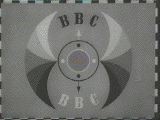 Television sets manufactured before the 1970s made extensive use of valves as opposed to more reliable “solid state” components such as transistors and integrated circuits; these valve-based sets often required adjustment of controls such as brightness and vertical hold before the start of the programme as well as allowing for a period for the TV to have warmed up properly, hence the BBC showing a caption known as a tuning signal for a while before the programme starts which enabled the teacher to make last minute adjustments to the picture settings if required. This Abram Games-designed “angel wings” tuning signal was shown before the start of each days’ broadcast in the 1950s, and continued to be used before schools programmes up until circa 1964, even after its use had been discontinued elsewhere.
Television sets manufactured before the 1970s made extensive use of valves as opposed to more reliable “solid state” components such as transistors and integrated circuits; these valve-based sets often required adjustment of controls such as brightness and vertical hold before the start of the programme as well as allowing for a period for the TV to have warmed up properly, hence the BBC showing a caption known as a tuning signal for a while before the programme starts which enabled the teacher to make last minute adjustments to the picture settings if required. This Abram Games-designed “angel wings” tuning signal was shown before the start of each days’ broadcast in the 1950s, and continued to be used before schools programmes up until circa 1964, even after its use had been discontinued elsewhere.
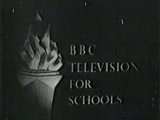 The first transmitted BBC programme for schools (Geography) was broadcast on 24 September 1957 from the Lime Grove studios, with only one schools programme shown each afternoon during term time to begin with, and all the initial programmes such as Living In The Commonwealth and Science and Life were predominantly aimed at older children. A short 5 second filmed ident sequence with orchestral accompaniment was used to introduce BBC Television For Schools (as it was called), and we can perhaps assume that this film was used as an opening sequence for schools programmes until the summer term of 1960; it had certainly been dropped by 1962 when the “Schools Opening Film” was 1 minute long in duration.
The first transmitted BBC programme for schools (Geography) was broadcast on 24 September 1957 from the Lime Grove studios, with only one schools programme shown each afternoon during term time to begin with, and all the initial programmes such as Living In The Commonwealth and Science and Life were predominantly aimed at older children. A short 5 second filmed ident sequence with orchestral accompaniment was used to introduce BBC Television For Schools (as it was called), and we can perhaps assume that this film was used as an opening sequence for schools programmes until the summer term of 1960; it had certainly been dropped by 1962 when the “Schools Opening Film” was 1 minute long in duration.
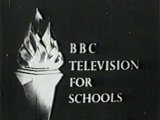 During the last second of the ident sequence, the torch (and the caption) momentarily flickered brighter before the continuity announcer appeared on-screen to formally introduce the programme; something that may also relate to the flashes of light used for the “bat’s wings” logo from the same period. (Indeed, elements of the “bat’s wings” design with flashes of light could be seen being used in schools continuity until October 1961; a year after it was discontinued elsewhere.) Even by 1950s standards, this style of on-screen presentation was surprisingly old-fashioned but presumably a traditional look was adopted in order to appeal to teachers that were reluctant to embrace modern technology in the classroom. However despite an initial lack of programming, schools quickly warmed to the idea of television as a teaching medium and they were eagerly buying televisions to such an extent that they had to be restrained from excessively doing so.
During the last second of the ident sequence, the torch (and the caption) momentarily flickered brighter before the continuity announcer appeared on-screen to formally introduce the programme; something that may also relate to the flashes of light used for the “bat’s wings” logo from the same period. (Indeed, elements of the “bat’s wings” design with flashes of light could be seen being used in schools continuity until October 1961; a year after it was discontinued elsewhere.) Even by 1950s standards, this style of on-screen presentation was surprisingly old-fashioned but presumably a traditional look was adopted in order to appeal to teachers that were reluctant to embrace modern technology in the classroom. However despite an initial lack of programming, schools quickly warmed to the idea of television as a teaching medium and they were eagerly buying televisions to such an extent that they had to be restrained from excessively doing so.
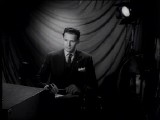 A promotional film This is the BBC gives us a brief insight into the production of schools programmes during the late 1950s; the continuity announcer pictured here is introducing Programme 3 of the series Transport and Communication. The BBC actually referred to schools broadcasts in period literature as being “Broadcasts To Schools”.
A promotional film This is the BBC gives us a brief insight into the production of schools programmes during the late 1950s; the continuity announcer pictured here is introducing Programme 3 of the series Transport and Communication. The BBC actually referred to schools broadcasts in period literature as being “Broadcasts To Schools”.
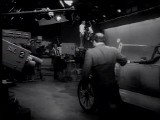 Programme 3 of the aforementioned Transport and Communication series was all about the history of the motor car, so an example of the very first mass produced car – the Model T Ford – was placed in the studio. The presenter was Arthur Garratt (pictured here next to the car).
Programme 3 of the aforementioned Transport and Communication series was all about the history of the motor car, so an example of the very first mass produced car – the Model T Ford – was placed in the studio. The presenter was Arthur Garratt (pictured here next to the car).
The Autumn Term of 1960 saw the introduction of a much more comprehensive selection of BBC schools programming shown during term time, and schools programmes were preceded by the “angel wings” tuning signal followed by a 1 minute-long “Schools Opening Film” accompanied by a piece of music which may have been composed by Lionel Salter. Perhaps surprisingly, nobody seems to recall what this opening film consisted of, but it’s likely to have featured the pie chart tuning signal (see below) because a filmed version of the pie chart featured the 1960-style corporate BBC logo in square boxes. Schools programmes shown during this period included Life in a Physical World and Making Music (1963-72).
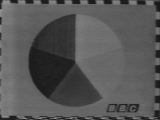 The tuning signal caption shown here is likely to have been first used as early as Autumn Term 1960 (when a morning schools programme was introduced); it was used before the start of each schools programme and consisted of a circle divided into five segments of black, white and three shades of grey in the style of a pie chart on a pale grey background, hence the term “BBC Schools Pie Chart”. From (at least) 1964 to 1967 there was a countdown sequence used before the start of the programme which had the pie chart slowly disappear; the circular chart was divided into small segments, with each segment of the pie chart being replaced by the corresponding segment of a plain clock face (identical to the clock face below minus the second hand) starting from the top, one for each second in a clockwise direction. A piece of music written by Lionel Salter entitled “We are almost ready to begin” was used to accompany the animation from 1964 onwards, and the tune’s duration was 1 minute 55 seconds, with 5 seconds’ silence for the announcement ID. (The first pie chart was also branded ‘BBC tv’ unlike the BBC branding shown here that was used from 1967 onwards.)
The tuning signal caption shown here is likely to have been first used as early as Autumn Term 1960 (when a morning schools programme was introduced); it was used before the start of each schools programme and consisted of a circle divided into five segments of black, white and three shades of grey in the style of a pie chart on a pale grey background, hence the term “BBC Schools Pie Chart”. From (at least) 1964 to 1967 there was a countdown sequence used before the start of the programme which had the pie chart slowly disappear; the circular chart was divided into small segments, with each segment of the pie chart being replaced by the corresponding segment of a plain clock face (identical to the clock face below minus the second hand) starting from the top, one for each second in a clockwise direction. A piece of music written by Lionel Salter entitled “We are almost ready to begin” was used to accompany the animation from 1964 onwards, and the tune’s duration was 1 minute 55 seconds, with 5 seconds’ silence for the announcement ID. (The first pie chart was also branded ‘BBC tv’ unlike the BBC branding shown here that was used from 1967 onwards.)
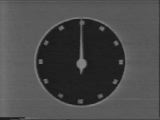 From 1967 until (at least) November 1974, the ‘vanishing segments’ animation used for the final minute was replaced by this simple clock face with a single continuously moving second hand, though the pie chart itself was still being shown prior to the final minute countdown to the programme start; the accompanying music now being used was usually a percussive piece known as “Guadalajara” that was written by Leonard Salzedo (who also wrote the Open University theme that was the first few bars of a longer piece). Broadcast quality copies (albeit recorded on film) of this pie chart and clock sequence exist before the start of some BBC Northern Ireland schools programmes because an ident was sometimes recorded alongside the programme.
From 1967 until (at least) November 1974, the ‘vanishing segments’ animation used for the final minute was replaced by this simple clock face with a single continuously moving second hand, though the pie chart itself was still being shown prior to the final minute countdown to the programme start; the accompanying music now being used was usually a percussive piece known as “Guadalajara” that was written by Leonard Salzedo (who also wrote the Open University theme that was the first few bars of a longer piece). Broadcast quality copies (albeit recorded on film) of this pie chart and clock sequence exist before the start of some BBC Northern Ireland schools programmes because an ident was sometimes recorded alongside the programme.
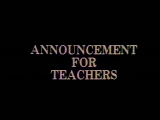 Occasionally an “Announcement For Teachers” may have been read during the final minute whilst the clock hand was steadily moving around the face to the 12 o’clock position when the programme starts, with this caption being overlaid on the clock, but more commonly such announcements were made at other times when this caption on its own would have been displayed. (The same caption was also used later in the 1970s for announcements.)
Occasionally an “Announcement For Teachers” may have been read during the final minute whilst the clock hand was steadily moving around the face to the 12 o’clock position when the programme starts, with this caption being overlaid on the clock, but more commonly such announcements were made at other times when this caption on its own would have been displayed. (The same caption was also used later in the 1970s for announcements.)
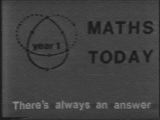 Then of course there were the programmes themselves – BBC Schools programming caters for a wide range of subjects and abilities, with series such as Maths Today and Maths Workshop (for older children); the latter being shown well into the 1970s despite being made in black and white. Programmes were often repeated for the benefit of teachers so that they could try and incorporate them into the school timetable which was often difficult since many schools had no form of video recording at that time.
Then of course there were the programmes themselves – BBC Schools programming caters for a wide range of subjects and abilities, with series such as Maths Today and Maths Workshop (for older children); the latter being shown well into the 1970s despite being made in black and white. Programmes were often repeated for the benefit of teachers so that they could try and incorporate them into the school timetable which was often difficult since many schools had no form of video recording at that time.
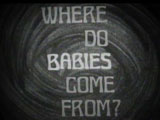 Here is an example of a BBC Schools sex education programme from the late 1960s that would inevitably provide a useful classroom resource triggering a discussion about the facts of life, with television being able to provide a far more powerful illustrative medium compared to books or blackboard drawings for this particular topic.
Here is an example of a BBC Schools sex education programme from the late 1960s that would inevitably provide a useful classroom resource triggering a discussion about the facts of life, with television being able to provide a far more powerful illustrative medium compared to books or blackboard drawings for this particular topic.
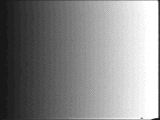 Very occasionally the pie chart tuning signal itself would feature as part of an engineering test startup sequence if such a test was scheduled for a weekday morning during term time, in which case the pie chart tuning signal would appear on screen then very slowly fade away over the course of a minute to leave a black screen before appearing again shortly before the start of the first programme. The sequence would also feature a greyscale (sawtooth) tuning pattern with tone.
Very occasionally the pie chart tuning signal itself would feature as part of an engineering test startup sequence if such a test was scheduled for a weekday morning during term time, in which case the pie chart tuning signal would appear on screen then very slowly fade away over the course of a minute to leave a black screen before appearing again shortly before the start of the first programme. The sequence would also feature a greyscale (sawtooth) tuning pattern with tone.
Unfortunately no recording exists of such a sequence in the BBC archives, but if you have in your possession any video or audio recordings of BBC schools broadcasts that may be of interest please contact us.
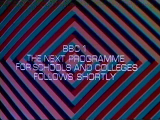 With more and more schools programmes being made in colour as well as more and more schools acquiring colour TV’s – though there were still a significant number of primary schools in particular that had only black and white televisions even at the end of the 1970s – the pie chart’s days were obviously numbered, therefore something more contemporary was devised for schools programme presentation.
With more and more schools programmes being made in colour as well as more and more schools acquiring colour TV’s – though there were still a significant number of primary schools in particular that had only black and white televisions even at the end of the 1970s – the pie chart’s days were obviously numbered, therefore something more contemporary was devised for schools programme presentation.
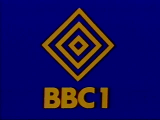
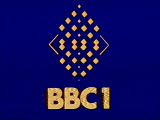
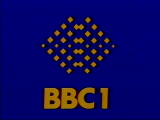
Dance of the diamonds…From 1974 to 1977 the BBC Schools Diamond animation was used before schools programmes, and the animation was created using perhaps the most elaborate mechanical model ever constructed for programme presentational purposes with mirrors being used to create some of the effect. The diamond starts off being fixed in size but with the lines growing thinner and fatter at intervals before the lines split into several dots whilst diamond shapes formed and changed their size.
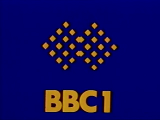
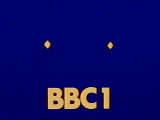
Towards the end of the sequence, two diamond shapes would vertically shrink down to a point where they vanished altogether, leading into the start of the programme. Two pieces of music were used to accompany the animation depending on whether the following programme was aimed at primary or secondary/higher education. There was also a pale blue version of the diamond complete with a different, corporate-style rhomboid BBC1 logo shown in Northern Ireland as well as a still caption of a diamond with BBC2 branding used on rare occasions when schools programming was moved to BBC2.
 Examples of BBC Schools programmes shown during the 1970s include A Good Read, A Job Worth Doing?, Going To Work, Maths Topics, Mathshow, Merry-go-round for primary school children, Scene, Swim, and Watch. Some of these programmes continued to be produced or shown for years after the 1970s but the introduction of GCSE qualifications (replacing ‘O’ levels, with the first GCSE exams in the Summer of 1988) made some of these old programmes redundant.
Examples of BBC Schools programmes shown during the 1970s include A Good Read, A Job Worth Doing?, Going To Work, Maths Topics, Mathshow, Merry-go-round for primary school children, Scene, Swim, and Watch. Some of these programmes continued to be produced or shown for years after the 1970s but the introduction of GCSE qualifications (replacing ‘O’ levels, with the first GCSE exams in the Summer of 1988) made some of these old programmes redundant.
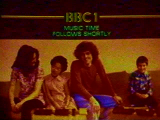
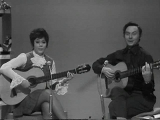
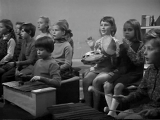
A few schools programmes originally made in black and white continued to be shown throughout the decade, including series like Maths Workshop and Music Time. The promotions for programmes like these might have been in colour but that didn’t necessarily mean that the programme itself was in colour.
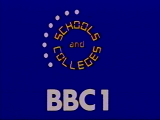 From 1977 onwards until the Summer Term of 1983 a “dots clock” was used as a replacement for the diamond animation before schools programmes, with a full circle of dots shown when the clock first appears. When watching the dots disappear one by one clockwise each second as the clock counts down to the start of the programme, you may notice that the dots don’t instantly disappear but seem to shrink as they vanish due to the mechanical nature of the clock. Various pieces of music were used to accompany the clock, including Cat Stevens’ Remember the days of the old schoolyard, a medley of ABBA songs and a rather memorable cover version of the original Star Wars theme. Originally the Schools and Colleges logo in the centre of the clock rotated every so often but it’s very likely that the turning mechanism broke down early on because the logo became static at some point not too long after the clock was first used.
From 1977 onwards until the Summer Term of 1983 a “dots clock” was used as a replacement for the diamond animation before schools programmes, with a full circle of dots shown when the clock first appears. When watching the dots disappear one by one clockwise each second as the clock counts down to the start of the programme, you may notice that the dots don’t instantly disappear but seem to shrink as they vanish due to the mechanical nature of the clock. Various pieces of music were used to accompany the clock, including Cat Stevens’ Remember the days of the old schoolyard, a medley of ABBA songs and a rather memorable cover version of the original Star Wars theme. Originally the Schools and Colleges logo in the centre of the clock rotated every so often but it’s very likely that the turning mechanism broke down early on because the logo became static at some point not too long after the clock was first used.
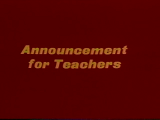 Autumn Term 1983 saw schools programmes permanently move to BBC2 and the use of a dots clock was abandoned at this point in favour of a more conventional “Daytime on 2” style of continuity, though the “Coming Shortly…” method of filling short gaps in the schedule continued for a while longer as well as a 15 second digital countdown timer being adopted later on in the decade. More and more schools now had video recorders so could easily record programmes and play them back at times to suit the lessons as opposed to timing the lessons to fit in with the television programmes.
Autumn Term 1983 saw schools programmes permanently move to BBC2 and the use of a dots clock was abandoned at this point in favour of a more conventional “Daytime on 2” style of continuity, though the “Coming Shortly…” method of filling short gaps in the schedule continued for a while longer as well as a 15 second digital countdown timer being adopted later on in the decade. More and more schools now had video recorders so could easily record programmes and play them back at times to suit the lessons as opposed to timing the lessons to fit in with the television programmes.